Competitive Strategy Report: Analyzing Tesco's Business Tactics
VerifiedAdded on 2023/02/01
|9
|1737
|82
Report
AI Summary
This report offers a comprehensive strategic analysis of Tesco, a leading UK-based retail organization. It begins with an introduction to strategic tools and their importance in business growth. The report then applies the PESTLE model to assess Tesco's external environment, considering political, economic, social, technological, environmental, and legal factors. Following this, a SWOT analysis examines Tesco's strengths, weaknesses, opportunities, and threats. The Porter Five Forces model is used to evaluate the competitive forces within the industry. Finally, the Ansoff matrix helps analyze Tesco's market penetration, product development, market development, and diversification strategies. The report concludes by emphasizing the effectiveness of these tools in aiding strategic decision-making and gaining a competitive advantage.
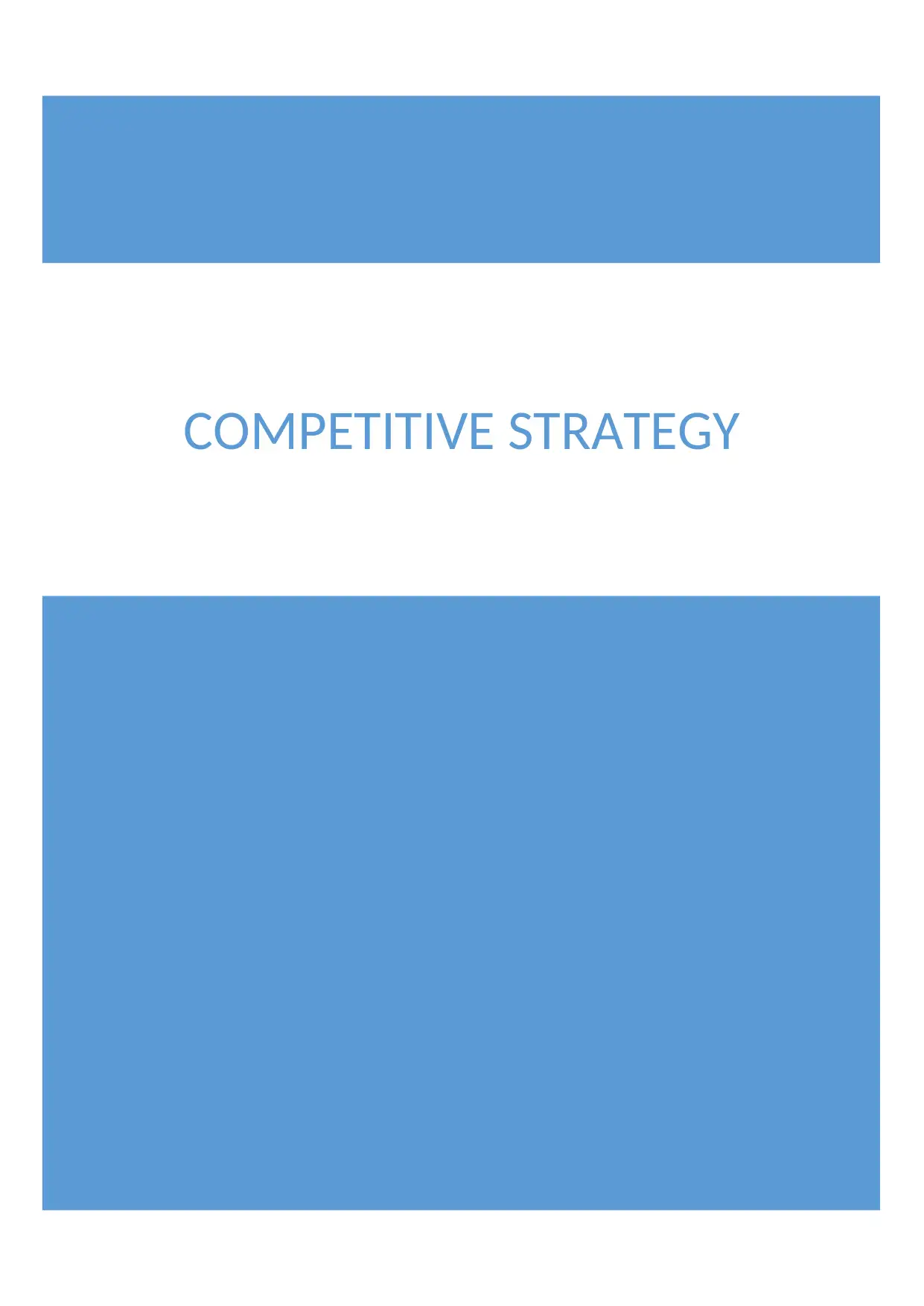
COMPETITIVE STRATEGY
Paraphrase This Document
Need a fresh take? Get an instant paraphrase of this document with our AI Paraphraser

Contents
Introduction...........................................................................................................................................3
PESTLE MODEL......................................................................................................................................3
SWOT Model.........................................................................................................................................5
Porter Five Force model........................................................................................................................6
Ans-off matrix........................................................................................................................................7
Conclusion.............................................................................................................................................8
References.............................................................................................................................................9
Introduction...........................................................................................................................................3
PESTLE MODEL......................................................................................................................................3
SWOT Model.........................................................................................................................................5
Porter Five Force model........................................................................................................................6
Ans-off matrix........................................................................................................................................7
Conclusion.............................................................................................................................................8
References.............................................................................................................................................9
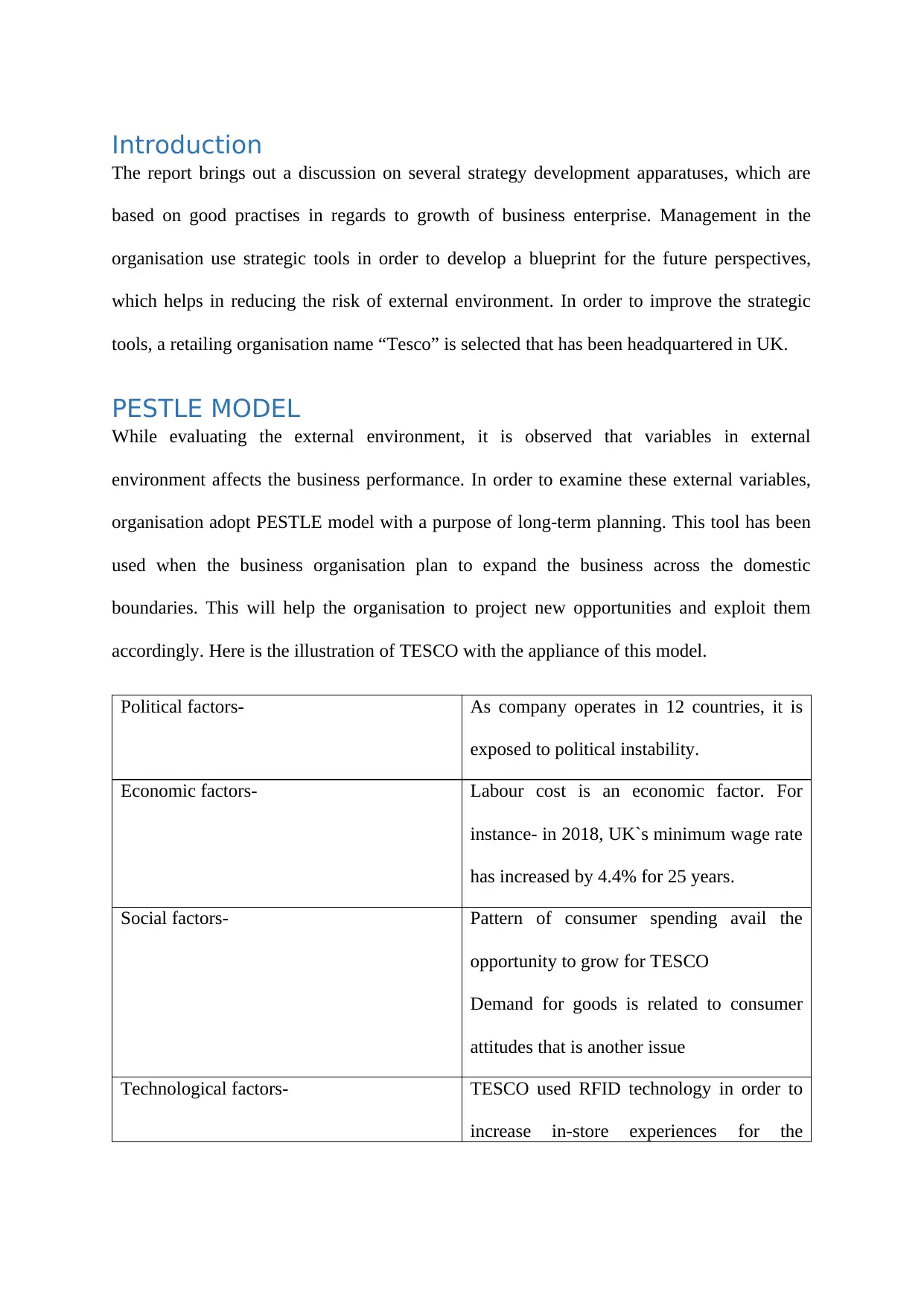
Introduction
The report brings out a discussion on several strategy development apparatuses, which are
based on good practises in regards to growth of business enterprise. Management in the
organisation use strategic tools in order to develop a blueprint for the future perspectives,
which helps in reducing the risk of external environment. In order to improve the strategic
tools, a retailing organisation name “Tesco” is selected that has been headquartered in UK.
PESTLE MODEL
While evaluating the external environment, it is observed that variables in external
environment affects the business performance. In order to examine these external variables,
organisation adopt PESTLE model with a purpose of long-term planning. This tool has been
used when the business organisation plan to expand the business across the domestic
boundaries. This will help the organisation to project new opportunities and exploit them
accordingly. Here is the illustration of TESCO with the appliance of this model.
Political factors- As company operates in 12 countries, it is
exposed to political instability.
Economic factors- Labour cost is an economic factor. For
instance- in 2018, UK`s minimum wage rate
has increased by 4.4% for 25 years.
Social factors- Pattern of consumer spending avail the
opportunity to grow for TESCO
Demand for goods is related to consumer
attitudes that is another issue
Technological factors- TESCO used RFID technology in order to
increase in-store experiences for the
The report brings out a discussion on several strategy development apparatuses, which are
based on good practises in regards to growth of business enterprise. Management in the
organisation use strategic tools in order to develop a blueprint for the future perspectives,
which helps in reducing the risk of external environment. In order to improve the strategic
tools, a retailing organisation name “Tesco” is selected that has been headquartered in UK.
PESTLE MODEL
While evaluating the external environment, it is observed that variables in external
environment affects the business performance. In order to examine these external variables,
organisation adopt PESTLE model with a purpose of long-term planning. This tool has been
used when the business organisation plan to expand the business across the domestic
boundaries. This will help the organisation to project new opportunities and exploit them
accordingly. Here is the illustration of TESCO with the appliance of this model.
Political factors- As company operates in 12 countries, it is
exposed to political instability.
Economic factors- Labour cost is an economic factor. For
instance- in 2018, UK`s minimum wage rate
has increased by 4.4% for 25 years.
Social factors- Pattern of consumer spending avail the
opportunity to grow for TESCO
Demand for goods is related to consumer
attitudes that is another issue
Technological factors- TESCO used RFID technology in order to
increase in-store experiences for the
⊘ This is a preview!⊘
Do you want full access?
Subscribe today to unlock all pages.

Trusted by 1+ million students worldwide

customers.
For the convenient shopping, organisation
introduce “scan as you shop” as the
checkpoints.
Environmental factors- The company is facing immense pressure
from the government agencies in order to
address the environmental issues.
Van drivers of Tesco not only use fuel
saving routes that collect useless plastics
bags and recycle them
Legal factors- TESCO faces legal actions for accounting
fraud that has mispleaded the investors.
In 2016, Tesco works to undertake the legal
action against the low pay rates in the night
shift, holiday shift, and weekend.
The company has to comply with Food
Retailing commission (FRC) that is a strict
code of conduct.
It is important to consider all the above factors to achieve the long-term sustainability growth;
the company has to undertake market development strategies.
SWOT Model
SWOT Model is an strategic tool that help in examining organisation`s strengths,
opportunities, threats and weaknesses. This tool will help Tesco to take advantage of the
strengths in order to grab the various opportunities from the market and take preventive
For the convenient shopping, organisation
introduce “scan as you shop” as the
checkpoints.
Environmental factors- The company is facing immense pressure
from the government agencies in order to
address the environmental issues.
Van drivers of Tesco not only use fuel
saving routes that collect useless plastics
bags and recycle them
Legal factors- TESCO faces legal actions for accounting
fraud that has mispleaded the investors.
In 2016, Tesco works to undertake the legal
action against the low pay rates in the night
shift, holiday shift, and weekend.
The company has to comply with Food
Retailing commission (FRC) that is a strict
code of conduct.
It is important to consider all the above factors to achieve the long-term sustainability growth;
the company has to undertake market development strategies.
SWOT Model
SWOT Model is an strategic tool that help in examining organisation`s strengths,
opportunities, threats and weaknesses. This tool will help Tesco to take advantage of the
strengths in order to grab the various opportunities from the market and take preventive
Paraphrase This Document
Need a fresh take? Get an instant paraphrase of this document with our AI Paraphraser
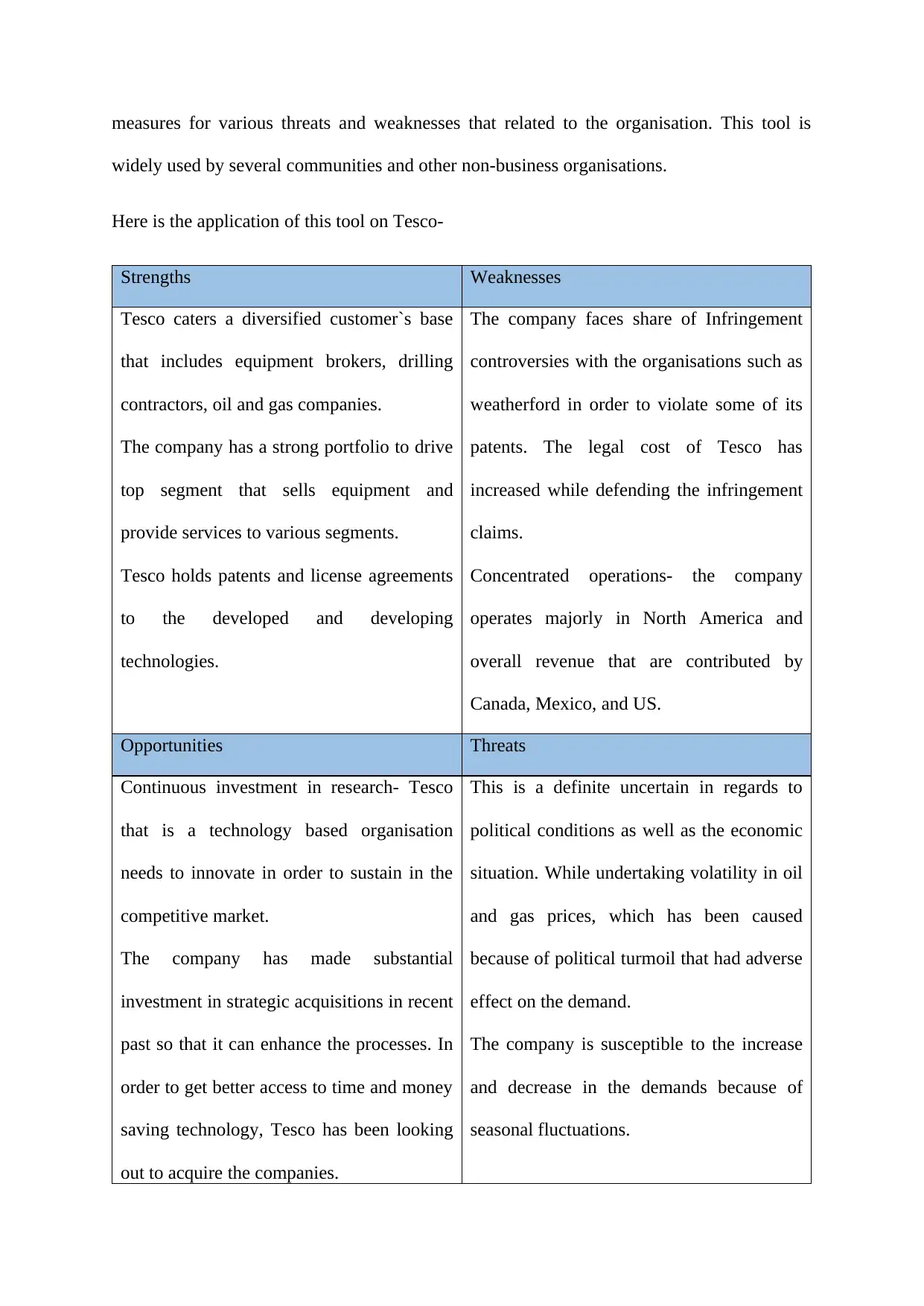
measures for various threats and weaknesses that related to the organisation. This tool is
widely used by several communities and other non-business organisations.
Here is the application of this tool on Tesco-
Strengths Weaknesses
Tesco caters a diversified customer`s base
that includes equipment brokers, drilling
contractors, oil and gas companies.
The company has a strong portfolio to drive
top segment that sells equipment and
provide services to various segments.
Tesco holds patents and license agreements
to the developed and developing
technologies.
The company faces share of Infringement
controversies with the organisations such as
weatherford in order to violate some of its
patents. The legal cost of Tesco has
increased while defending the infringement
claims.
Concentrated operations- the company
operates majorly in North America and
overall revenue that are contributed by
Canada, Mexico, and US.
Opportunities Threats
Continuous investment in research- Tesco
that is a technology based organisation
needs to innovate in order to sustain in the
competitive market.
The company has made substantial
investment in strategic acquisitions in recent
past so that it can enhance the processes. In
order to get better access to time and money
saving technology, Tesco has been looking
out to acquire the companies.
This is a definite uncertain in regards to
political conditions as well as the economic
situation. While undertaking volatility in oil
and gas prices, which has been caused
because of political turmoil that had adverse
effect on the demand.
The company is susceptible to the increase
and decrease in the demands because of
seasonal fluctuations.
widely used by several communities and other non-business organisations.
Here is the application of this tool on Tesco-
Strengths Weaknesses
Tesco caters a diversified customer`s base
that includes equipment brokers, drilling
contractors, oil and gas companies.
The company has a strong portfolio to drive
top segment that sells equipment and
provide services to various segments.
Tesco holds patents and license agreements
to the developed and developing
technologies.
The company faces share of Infringement
controversies with the organisations such as
weatherford in order to violate some of its
patents. The legal cost of Tesco has
increased while defending the infringement
claims.
Concentrated operations- the company
operates majorly in North America and
overall revenue that are contributed by
Canada, Mexico, and US.
Opportunities Threats
Continuous investment in research- Tesco
that is a technology based organisation
needs to innovate in order to sustain in the
competitive market.
The company has made substantial
investment in strategic acquisitions in recent
past so that it can enhance the processes. In
order to get better access to time and money
saving technology, Tesco has been looking
out to acquire the companies.
This is a definite uncertain in regards to
political conditions as well as the economic
situation. While undertaking volatility in oil
and gas prices, which has been caused
because of political turmoil that had adverse
effect on the demand.
The company is susceptible to the increase
and decrease in the demands because of
seasonal fluctuations.
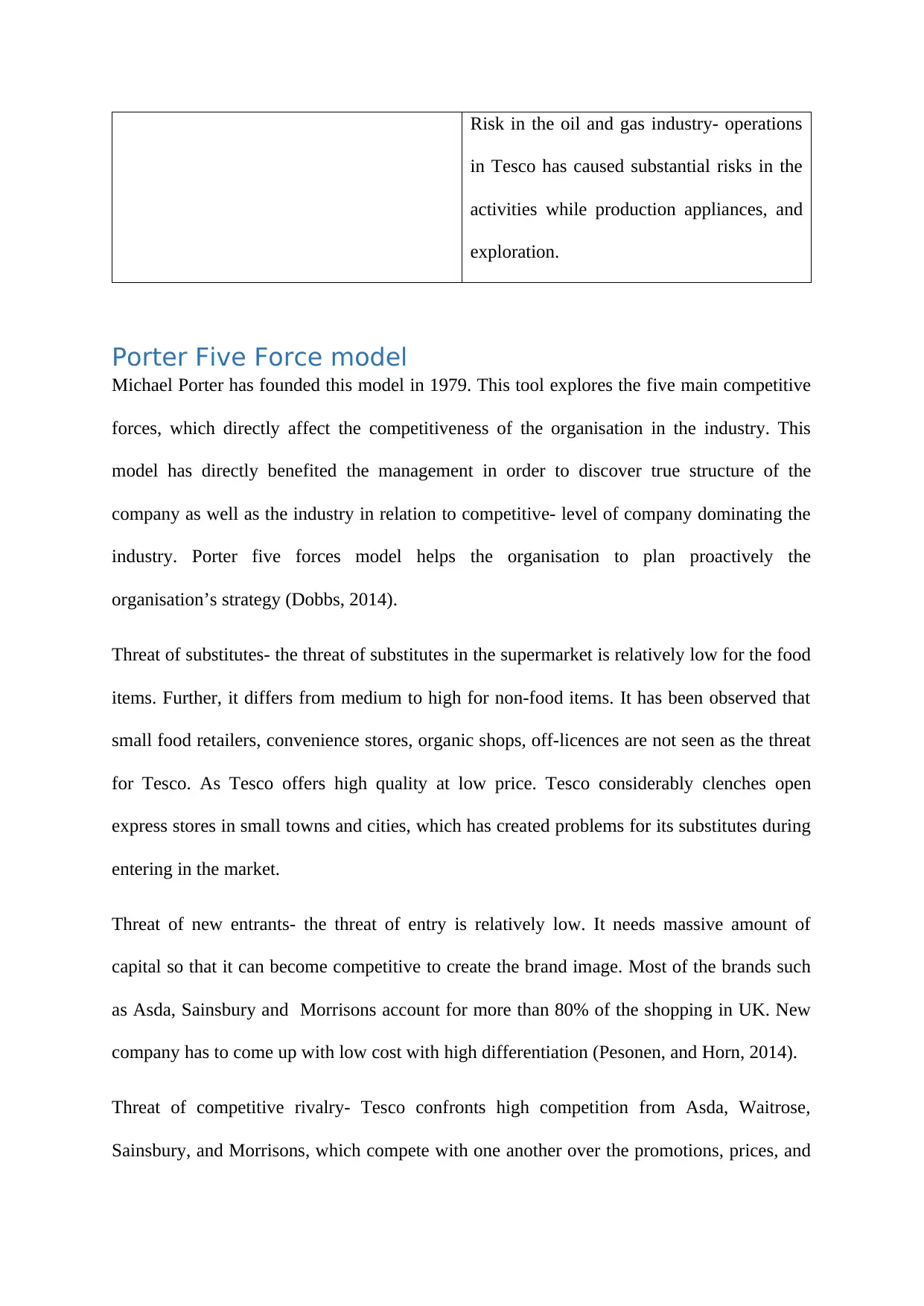
Risk in the oil and gas industry- operations
in Tesco has caused substantial risks in the
activities while production appliances, and
exploration.
Porter Five Force model
Michael Porter has founded this model in 1979. This tool explores the five main competitive
forces, which directly affect the competitiveness of the organisation in the industry. This
model has directly benefited the management in order to discover true structure of the
company as well as the industry in relation to competitive- level of company dominating the
industry. Porter five forces model helps the organisation to plan proactively the
organisation’s strategy (Dobbs, 2014).
Threat of substitutes- the threat of substitutes in the supermarket is relatively low for the food
items. Further, it differs from medium to high for non-food items. It has been observed that
small food retailers, convenience stores, organic shops, off-licences are not seen as the threat
for Tesco. As Tesco offers high quality at low price. Tesco considerably clenches open
express stores in small towns and cities, which has created problems for its substitutes during
entering in the market.
Threat of new entrants- the threat of entry is relatively low. It needs massive amount of
capital so that it can become competitive to create the brand image. Most of the brands such
as Asda, Sainsbury and Morrisons account for more than 80% of the shopping in UK. New
company has to come up with low cost with high differentiation (Pesonen, and Horn, 2014).
Threat of competitive rivalry- Tesco confronts high competition from Asda, Waitrose,
Sainsbury, and Morrisons, which compete with one another over the promotions, prices, and
in Tesco has caused substantial risks in the
activities while production appliances, and
exploration.
Porter Five Force model
Michael Porter has founded this model in 1979. This tool explores the five main competitive
forces, which directly affect the competitiveness of the organisation in the industry. This
model has directly benefited the management in order to discover true structure of the
company as well as the industry in relation to competitive- level of company dominating the
industry. Porter five forces model helps the organisation to plan proactively the
organisation’s strategy (Dobbs, 2014).
Threat of substitutes- the threat of substitutes in the supermarket is relatively low for the food
items. Further, it differs from medium to high for non-food items. It has been observed that
small food retailers, convenience stores, organic shops, off-licences are not seen as the threat
for Tesco. As Tesco offers high quality at low price. Tesco considerably clenches open
express stores in small towns and cities, which has created problems for its substitutes during
entering in the market.
Threat of new entrants- the threat of entry is relatively low. It needs massive amount of
capital so that it can become competitive to create the brand image. Most of the brands such
as Asda, Sainsbury and Morrisons account for more than 80% of the shopping in UK. New
company has to come up with low cost with high differentiation (Pesonen, and Horn, 2014).
Threat of competitive rivalry- Tesco confronts high competition from Asda, Waitrose,
Sainsbury, and Morrisons, which compete with one another over the promotions, prices, and
⊘ This is a preview!⊘
Do you want full access?
Subscribe today to unlock all pages.

Trusted by 1+ million students worldwide

products (Lofstrom, Bates, and Parker, 2014). The slow market growth directs growing
market stake of competitors that have increased market rivalry which has been frightening
Tesco`s cost-leadership position.
Bargaining power of customers-, it is relatively high. If customers get a little more
differentiation and more standardised, the cost of switching is low (Lee, Harindranath, Oh,
and Kim, 2015).
Bargaining power of suppliers- it is considerably low because suppliers who has inclined to
major food and grocery retailers suffer from the risk of dread losing (Jarzabkowski, and
Kaplan, 2015).
Ans-off matrix
With the help of Ansoff matrix, Tesco has analysed the company on the basis of market and
product.
Market penetration- The organisation can penetrate the market with the existing product
range. Tesco has huge product range, so grabbing the market share through penetration is not
at all tough (Hussain, Khattak, Rizwan, and Latif, 2013).
Product development- Tesco identifies the opportunity required when it develops the new
product in order to capture the market. For instance- organic products develops with the
changing preferences and habits of the customers. Tesco prefers one-stop solution.
Market development- Tesco has already developed its market outside UK as it has tapped the
emerging countries. The company is trying to penetrate with the grocery business in the
selected countries. New market development for Tesco will help the organisation to make
sure that it is competitive in the business (Gray, Harymawan, and Nowland, 2016).
market stake of competitors that have increased market rivalry which has been frightening
Tesco`s cost-leadership position.
Bargaining power of customers-, it is relatively high. If customers get a little more
differentiation and more standardised, the cost of switching is low (Lee, Harindranath, Oh,
and Kim, 2015).
Bargaining power of suppliers- it is considerably low because suppliers who has inclined to
major food and grocery retailers suffer from the risk of dread losing (Jarzabkowski, and
Kaplan, 2015).
Ans-off matrix
With the help of Ansoff matrix, Tesco has analysed the company on the basis of market and
product.
Market penetration- The organisation can penetrate the market with the existing product
range. Tesco has huge product range, so grabbing the market share through penetration is not
at all tough (Hussain, Khattak, Rizwan, and Latif, 2013).
Product development- Tesco identifies the opportunity required when it develops the new
product in order to capture the market. For instance- organic products develops with the
changing preferences and habits of the customers. Tesco prefers one-stop solution.
Market development- Tesco has already developed its market outside UK as it has tapped the
emerging countries. The company is trying to penetrate with the grocery business in the
selected countries. New market development for Tesco will help the organisation to make
sure that it is competitive in the business (Gray, Harymawan, and Nowland, 2016).
Paraphrase This Document
Need a fresh take? Get an instant paraphrase of this document with our AI Paraphraser
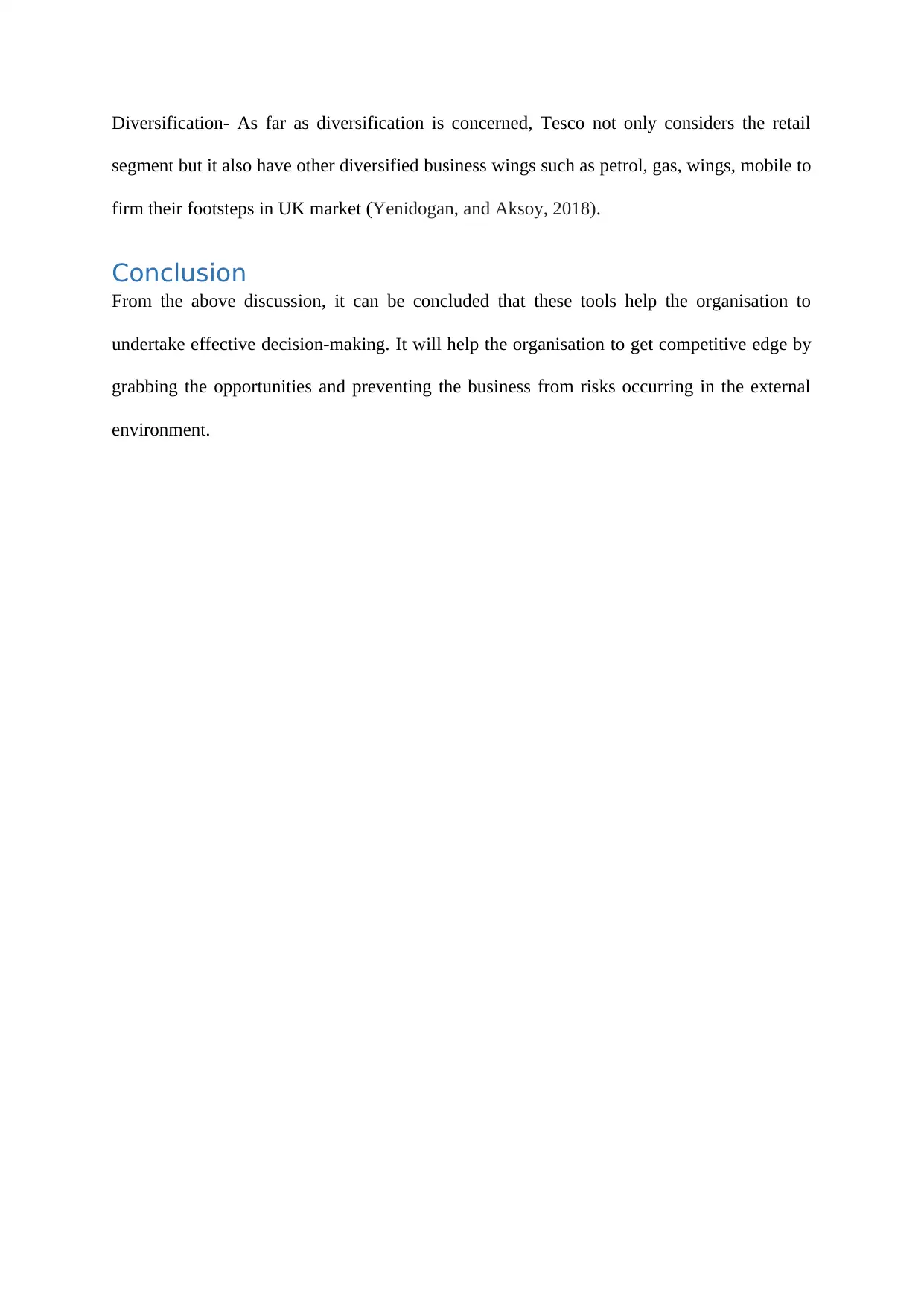
Diversification- As far as diversification is concerned, Tesco not only considers the retail
segment but it also have other diversified business wings such as petrol, gas, wings, mobile to
firm their footsteps in UK market (Yenidogan, and Aksoy, 2018).
Conclusion
From the above discussion, it can be concluded that these tools help the organisation to
undertake effective decision-making. It will help the organisation to get competitive edge by
grabbing the opportunities and preventing the business from risks occurring in the external
environment.
segment but it also have other diversified business wings such as petrol, gas, wings, mobile to
firm their footsteps in UK market (Yenidogan, and Aksoy, 2018).
Conclusion
From the above discussion, it can be concluded that these tools help the organisation to
undertake effective decision-making. It will help the organisation to get competitive edge by
grabbing the opportunities and preventing the business from risks occurring in the external
environment.
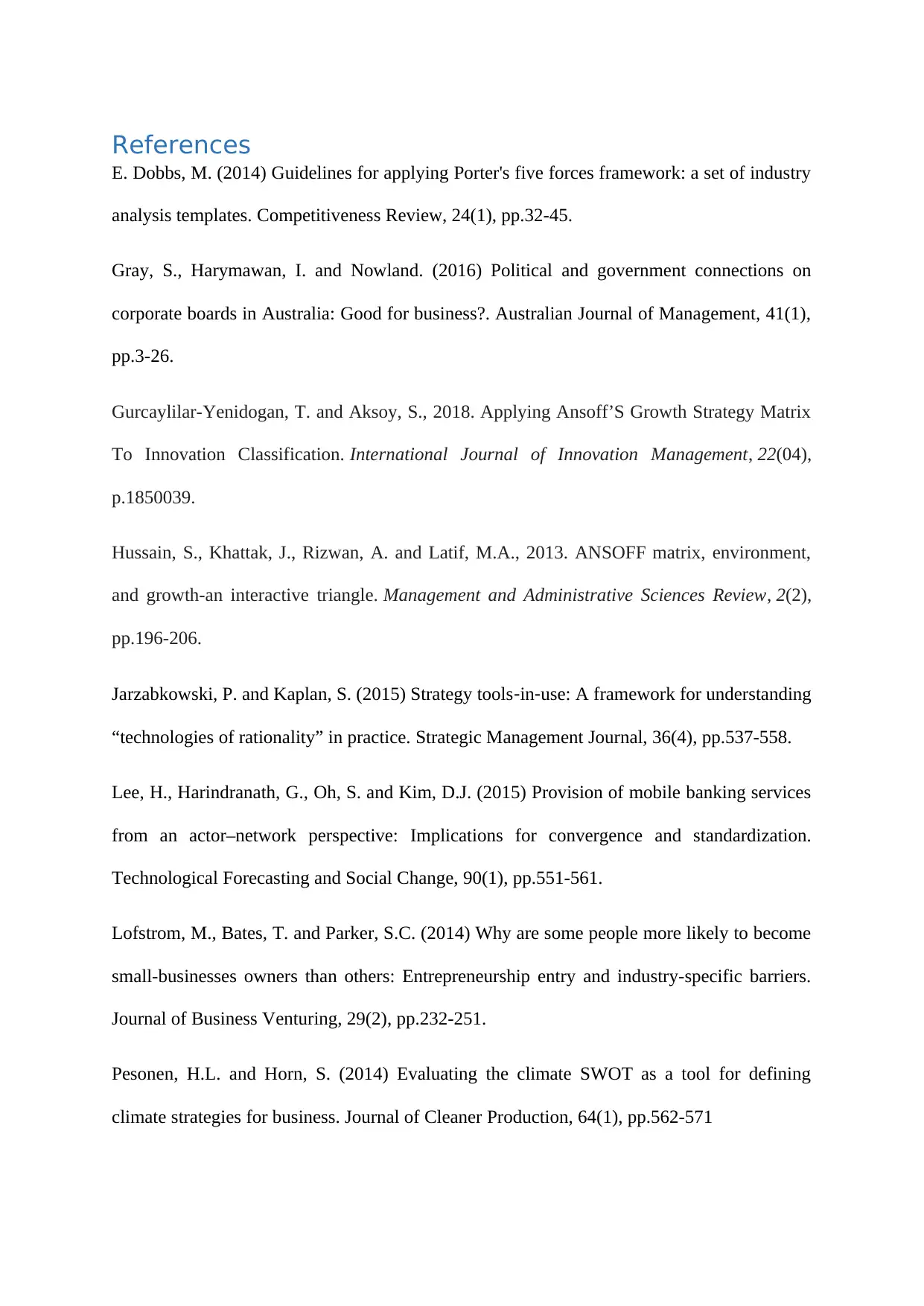
References
E. Dobbs, M. (2014) Guidelines for applying Porter's five forces framework: a set of industry
analysis templates. Competitiveness Review, 24(1), pp.32-45.
Gray, S., Harymawan, I. and Nowland. (2016) Political and government connections on
corporate boards in Australia: Good for business?. Australian Journal of Management, 41(1),
pp.3-26.
Gurcaylilar-Yenidogan, T. and Aksoy, S., 2018. Applying Ansoff’S Growth Strategy Matrix
To Innovation Classification. International Journal of Innovation Management, 22(04),
p.1850039.
Hussain, S., Khattak, J., Rizwan, A. and Latif, M.A., 2013. ANSOFF matrix, environment,
and growth-an interactive triangle. Management and Administrative Sciences Review, 2(2),
pp.196-206.
Jarzabkowski, P. and Kaplan, S. (2015) Strategy tools‐in‐use: A framework for understanding
“technologies of rationality” in practice. Strategic Management Journal, 36(4), pp.537-558.
Lee, H., Harindranath, G., Oh, S. and Kim, D.J. (2015) Provision of mobile banking services
from an actor–network perspective: Implications for convergence and standardization.
Technological Forecasting and Social Change, 90(1), pp.551-561.
Lofstrom, M., Bates, T. and Parker, S.C. (2014) Why are some people more likely to become
small-businesses owners than others: Entrepreneurship entry and industry-specific barriers.
Journal of Business Venturing, 29(2), pp.232-251.
Pesonen, H.L. and Horn, S. (2014) Evaluating the climate SWOT as a tool for defining
climate strategies for business. Journal of Cleaner Production, 64(1), pp.562-571
E. Dobbs, M. (2014) Guidelines for applying Porter's five forces framework: a set of industry
analysis templates. Competitiveness Review, 24(1), pp.32-45.
Gray, S., Harymawan, I. and Nowland. (2016) Political and government connections on
corporate boards in Australia: Good for business?. Australian Journal of Management, 41(1),
pp.3-26.
Gurcaylilar-Yenidogan, T. and Aksoy, S., 2018. Applying Ansoff’S Growth Strategy Matrix
To Innovation Classification. International Journal of Innovation Management, 22(04),
p.1850039.
Hussain, S., Khattak, J., Rizwan, A. and Latif, M.A., 2013. ANSOFF matrix, environment,
and growth-an interactive triangle. Management and Administrative Sciences Review, 2(2),
pp.196-206.
Jarzabkowski, P. and Kaplan, S. (2015) Strategy tools‐in‐use: A framework for understanding
“technologies of rationality” in practice. Strategic Management Journal, 36(4), pp.537-558.
Lee, H., Harindranath, G., Oh, S. and Kim, D.J. (2015) Provision of mobile banking services
from an actor–network perspective: Implications for convergence and standardization.
Technological Forecasting and Social Change, 90(1), pp.551-561.
Lofstrom, M., Bates, T. and Parker, S.C. (2014) Why are some people more likely to become
small-businesses owners than others: Entrepreneurship entry and industry-specific barriers.
Journal of Business Venturing, 29(2), pp.232-251.
Pesonen, H.L. and Horn, S. (2014) Evaluating the climate SWOT as a tool for defining
climate strategies for business. Journal of Cleaner Production, 64(1), pp.562-571
⊘ This is a preview!⊘
Do you want full access?
Subscribe today to unlock all pages.

Trusted by 1+ million students worldwide
1 out of 9
Related Documents
Your All-in-One AI-Powered Toolkit for Academic Success.
+13062052269
info@desklib.com
Available 24*7 on WhatsApp / Email
![[object Object]](/_next/static/media/star-bottom.7253800d.svg)
Unlock your academic potential
Copyright © 2020–2025 A2Z Services. All Rights Reserved. Developed and managed by ZUCOL.





